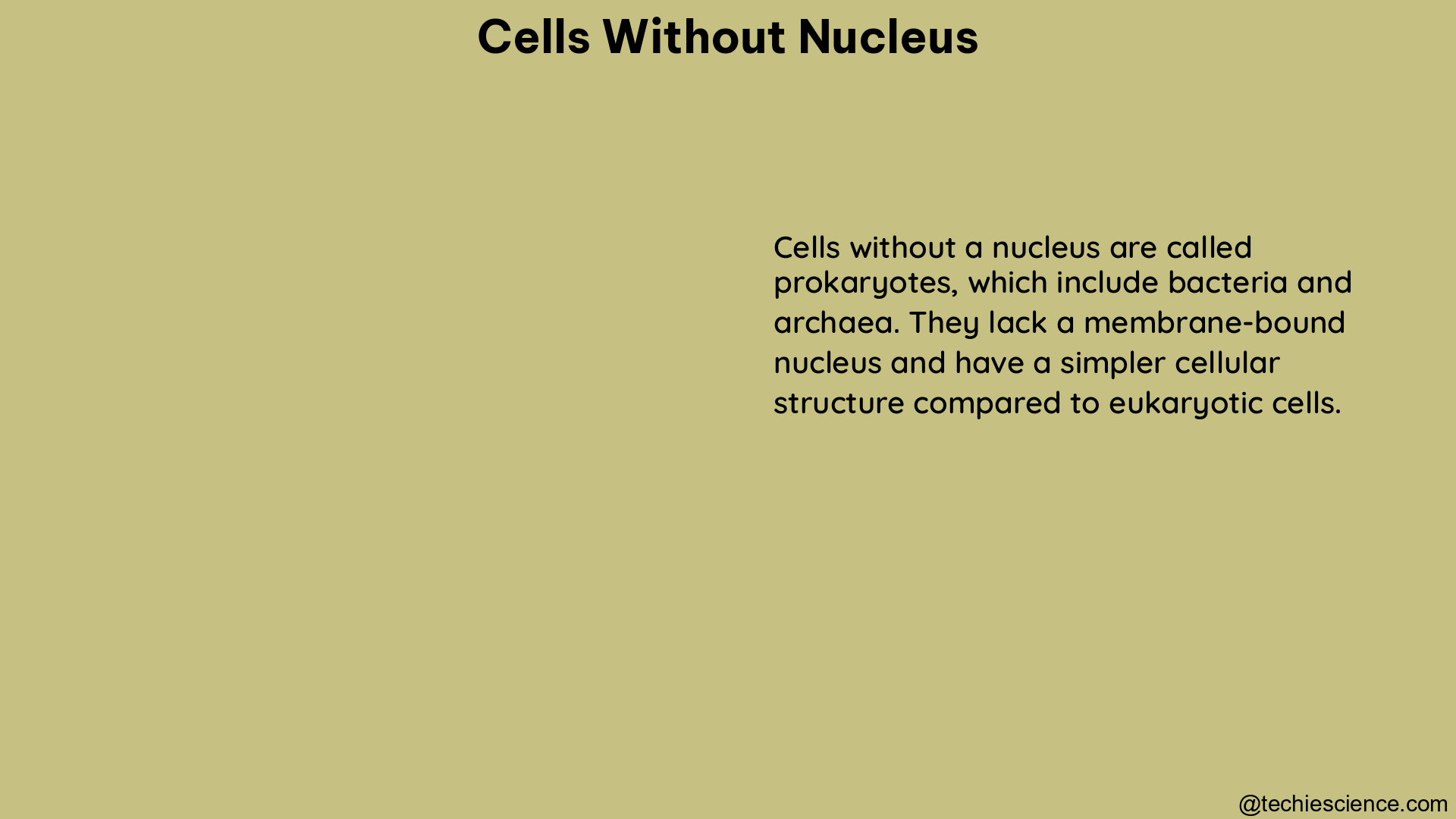Cells without nuclei, also known as anucleate cells, are a fascinating and unique subset of cellular structures that have captured the attention of biologists and researchers worldwide. These cells, despite lacking a central command center, continue to perform essential functions within the body, showcasing the remarkable adaptability and resilience of living organisms.
Understanding Anucleate Cells
Anucleate cells are cells that have lost their nucleus, the organelle responsible for housing the genetic material and controlling the cell’s activities. This loss of the nucleus can occur due to various biological processes, such as cell differentiation, programmed cell death, or mechanical stress. Despite this absence, these cells still maintain other essential organelles and cytoplasm, allowing them to carry out specific functions.
Measuring and Analyzing Anucleate Cells

One of the primary methods for studying and quantifying anucleate cells is through the use of advanced image analysis software, such as CellProfiler. This powerful tool enables researchers to measure a wide range of cellular features, including size, shape, intensity, and texture. Additionally, CellProfiler can be used to quantify the number and distribution of specific cellular components, such as proteins or organelles, providing valuable insights into the structure and function of anucleate cells.
CellProfiler: A Powerful Tool for Anucleate Cell Analysis
CellProfiler is a user-friendly, open-source software that has become a go-to tool for researchers studying anucleate cells. This software allows for the automated detection, segmentation, and measurement of individual cells within a given sample. By leveraging CellProfiler, researchers can obtain detailed data on the size, shape, and fluorescence intensity of anucleate cells, as well as the distribution and abundance of specific cellular components.
Key Features of CellProfiler for Anucleate Cell Analysis:
- Cell Detection: CellProfiler can accurately identify and segment individual cells, even in the absence of a distinct nucleus.
- Morphological Measurements: The software can quantify various morphological features of anucleate cells, such as area, perimeter, and shape.
- Fluorescence Intensity: CellProfiler can measure the intensity and distribution of fluorescently labeled cellular components, providing insights into the organization and function of anucleate cells.
- Batch Processing: The software’s ability to process multiple images in a batch allows for the efficient analysis of large datasets, enabling researchers to study anucleate cells at scale.
Detecting Cells Without Distinguishable Nuclei
In certain cell types, such as neurons, the nucleus may not be easily distinguishable, posing a challenge for traditional cell detection methods. In these cases, alternative approaches, like CellPose, can be employed to estimate the cytoplasmic borders of cells, allowing for the detection and analysis of anucleate cells.
CellPose is a deep learning-based algorithm that can accurately identify cell boundaries, even in the absence of a visible nucleus. By focusing on the cytoplasmic features of cells, CellPose enables the detection and quantification of anucleate cells, providing researchers with valuable data on their distribution, size, and other morphological characteristics.
Automated Cell Counting of Anucleate Cells
When it comes to quantifying the number of anucleate cells, automated methods are often preferred over manual counting due to their speed, accuracy, and reproducibility. Automated cell counters can operate using either impedance-based or imaging-based technologies, each with its own advantages.
Impedance-based Cell Counters
Impedance-based cell counters measure the changes in electrical resistance as cells pass through a small aperture, allowing for the detection and enumeration of individual cells. These counters are particularly useful for counting anucleate cells, as they can distinguish between live and dead cells based on their electrical properties.
Imaging-based Cell Counters
Imaging-based cell counters, on the other hand, utilize advanced microscopy techniques to capture and analyze images of cells. These counters can provide detailed information on the size, shape, and fluorescence characteristics of anucleate cells, in addition to their total count. The ability to distinguish between live and dead cells is a key advantage of imaging-based cell counters.
Quantifying Anucleate Cells: Data Points and Metrics
When studying anucleate cells, researchers often focus on quantifying various data points and metrics to gain a comprehensive understanding of their characteristics and behavior. Some of the key data points and metrics used in the analysis of anucleate cells include:
- Cell Count: The total number of anucleate cells present in a given sample, which can be obtained through automated cell counting methods.
- Cell Size: The average size (e.g., area, diameter) of anucleate cells, which can provide insights into their function and organization.
- Cell Shape: Measurements of the shape and morphology of anucleate cells, such as circularity, aspect ratio, and irregularity, can reveal information about their structure and potential roles.
- Fluorescence Intensity: The intensity and distribution of fluorescently labeled cellular components within anucleate cells, which can indicate the abundance and localization of specific proteins or organelles.
- Live/Dead Ratio: The proportion of live and dead anucleate cells within a sample, which can be determined using imaging-based cell counters.
- Spatial Distribution: The spatial arrangement and clustering patterns of anucleate cells, which can be analyzed using image analysis software like CellProfiler.
By quantifying these data points and metrics, researchers can gain a deeper understanding of the structure, function, and behavior of anucleate cells, ultimately contributing to the advancement of our knowledge in the field of cell biology.
Conclusion
Cells without nuclei, or anucleate cells, represent a fascinating and unique aspect of cellular biology. Through the use of advanced image analysis software, such as CellProfiler, and automated cell counting methods, researchers can now measure and analyze these remarkable cellular structures with unprecedented precision. By quantifying various data points and metrics, including cell count, size, shape, fluorescence intensity, and spatial distribution, scientists can uncover valuable insights into the role and function of anucleate cells within the complex and dynamic landscape of living organisms.
As our understanding of anucleate cells continues to evolve, the potential applications of this knowledge span a wide range of fields, from developmental biology and neuroscience to regenerative medicine and disease diagnostics. The study of cells without nuclei remains an active area of research, promising to yield new discoveries and advancements that will further our understanding of the fundamental principles of life.
References:
- Lamprecht, M. R., Sabatini, D. M., & Carpenter, A. E. (2007). CellProfiler: image analysis software for identifying and quantifying cell phenotypes. Genome biology, 8(3), R49.
- Gabriela. (2022). Cell detection – irregular cells/cells without distinguishable nuclei. Image.sc Forum.
- Jones, O. (2023). Counting Cells by Manual and Automated Methods | Biocompare. Biocompare.
- QuPath documentation on cell detection: https://qupath.readthedocs.io/en/0.4/docs/tutorials/cell_detection.html
- Discussion on the origin of life and the complexity of cells: https://biology.stackexchange.com/questions/48954/is-a-single-cell-irreducibly-complex

Hi, I am Saif Ali. I obtained my Master’s degree in Microbiology and have one year of research experience in water microbiology from National Institute of Hydrology, Roorkee. Antibiotic resistant microorganisms and soil bacteria, particularly PGPR, are my areas of interest and expertise. Currently, I’m focused on developing antibiotic alternatives. I’m always trying to discover new things from my surroundings. My goal is to provide readers with easy-to-understand microbiology articles.
If you have a bug, treat it with caution and avoid using antibiotics to combat SUPERBUGS.
Let’s connect via LinkedIn: